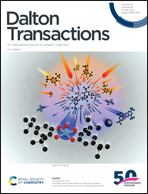Strong two-photon absorption and ultrafast dynamics of meso-functionalized “push–pull” trans-A2BC porphyrins†
Abstract
A new series of “push–pull” meso-substituted trans-A2BC porphyrins, where A = mesityl, B = phenothiazine (push) and C = o/p-nitrophenyl moiety (pull) and M = 2H, Ni(II), Cu(II), and Zn(II), were synthesized. These trans-A2BC porphyrins were characterized by various techniques viz. UV-Vis, fluorescence and NMR spectroscopy, matrix assisted laser desorption ionization-time of flight (MALDI-TOF) mass spectrometry, cyclic voltammetry, single-crystal X-ray diffraction analysis and density functional theory (DFT) studies. The single crystal structure of the newly synthesized free base trans-H2A2BC porphyrin (2) revealed the orientation of meso-substituents and the planar conformation of the porphyrin core. All newly synthesized free base trans-H2A2BC porphyrins (1 or 2) and their metal complexes exhibited a sharp Soret band. The first reduction potential of all synthesized trans-MA2BC porphyrins showed an anodic shift as compared with that of meso-tetraphenylporphyrins (MTPPs) due to the strong electron withdrawing nature of the nitrophenyl group. In general, the first oxidation potential of trans-MA2BC porphyrins shows a cathodic shift due to the electron donating phenothiazine moiety as compared to that of MTPPs. p-Nitrophenyl appended trans-A2BC porphyrins exhibited large ground state dipole moment values (8.59–9.64 D) as compared to MTPPs (0.0013–0.052 D) owing to the polarized “push–pull” effect of meso-substituents such as phenothiazine (push) and nitrophenyl (pull) moieties. Femtosecond nonlinear optical (NLO) studies performed with kHz pulses at 800 nm revealed strong two-photon absorption coefficients (∼0.082–0.0953 cm GW−1) and cross-sections (∼1.71–1.95 × 103 GM) for these “push–pull” porphyrins. We have also attempted to understand the NLO coefficients in terms of the structural changes in these porphyrin derivatives. A comparison that has been accomplished with similar porphyrin molecules and under similar experimental conditions revealed the superior performance of the title molecules. Furthermore, femtosecond transient absorption studies demonstrated several ultrafast processes from various excited states in these porphyrins, useful for identifying the processes relevant to optical switching applications.



 Please wait while we load your content...
Please wait while we load your content...